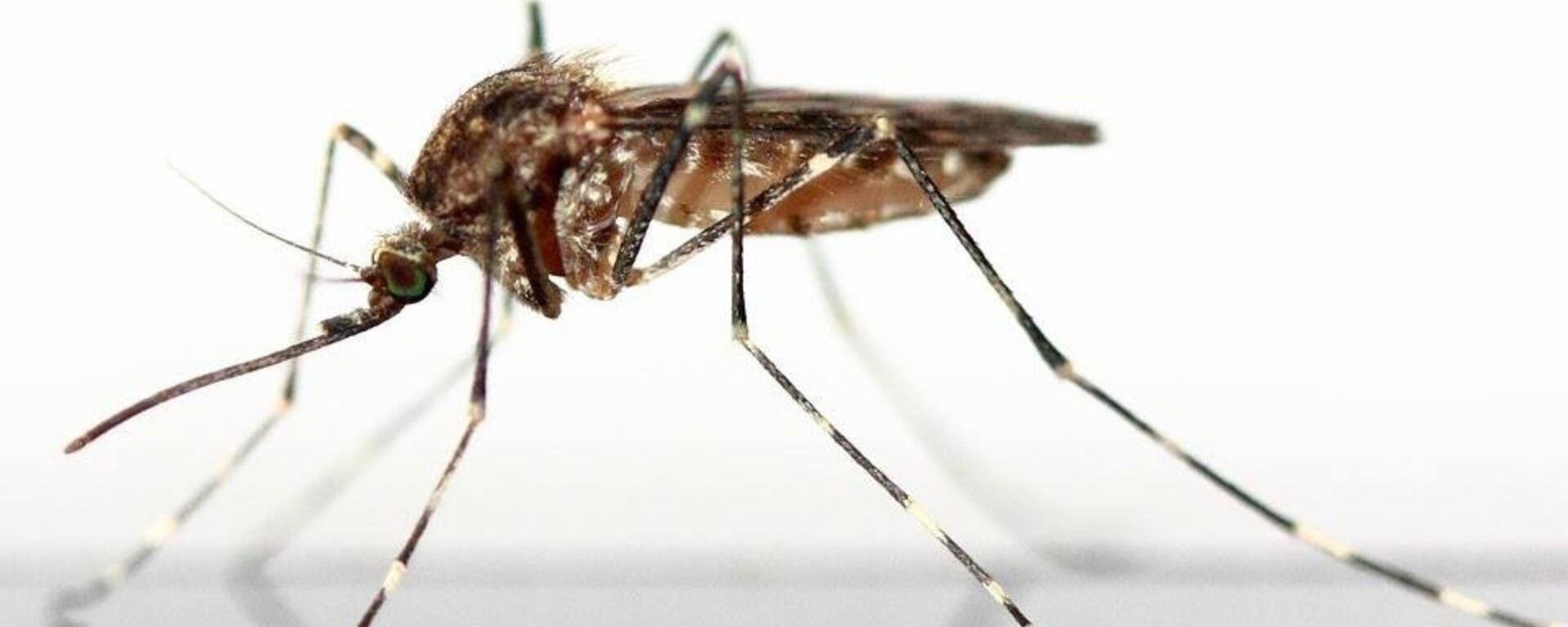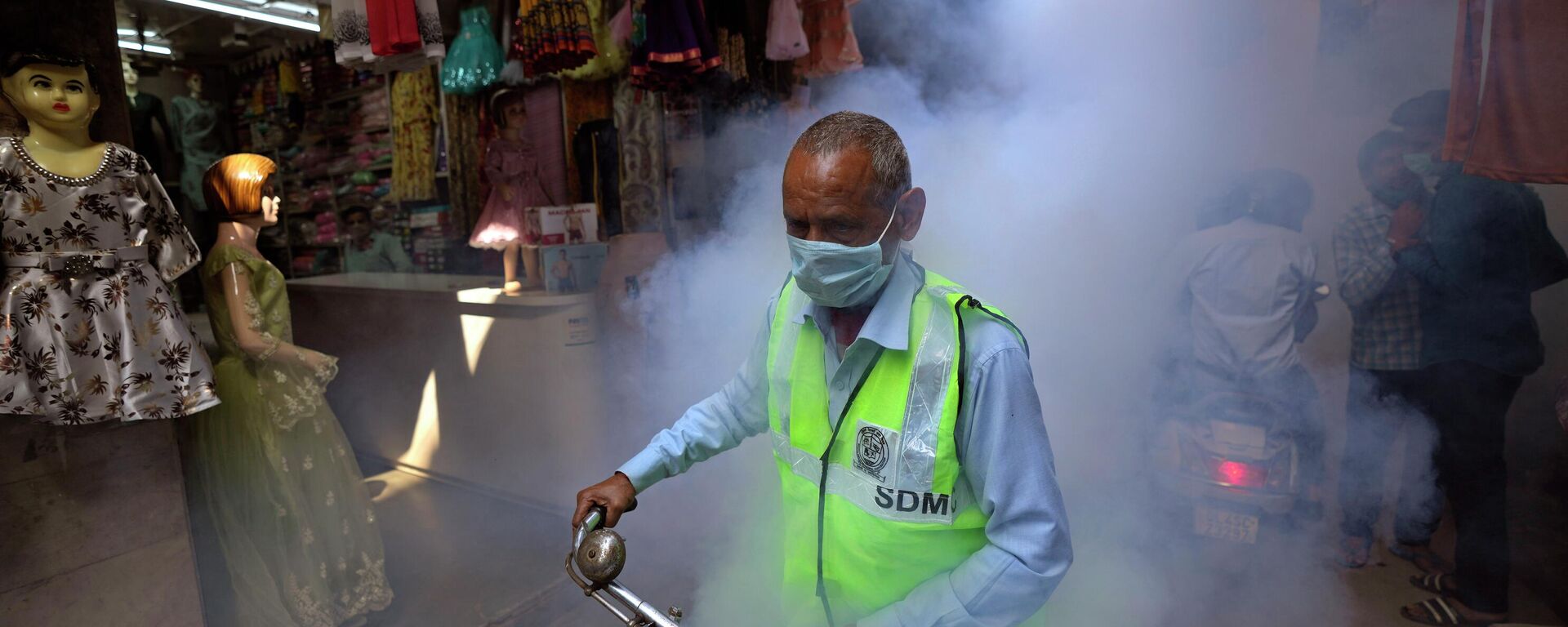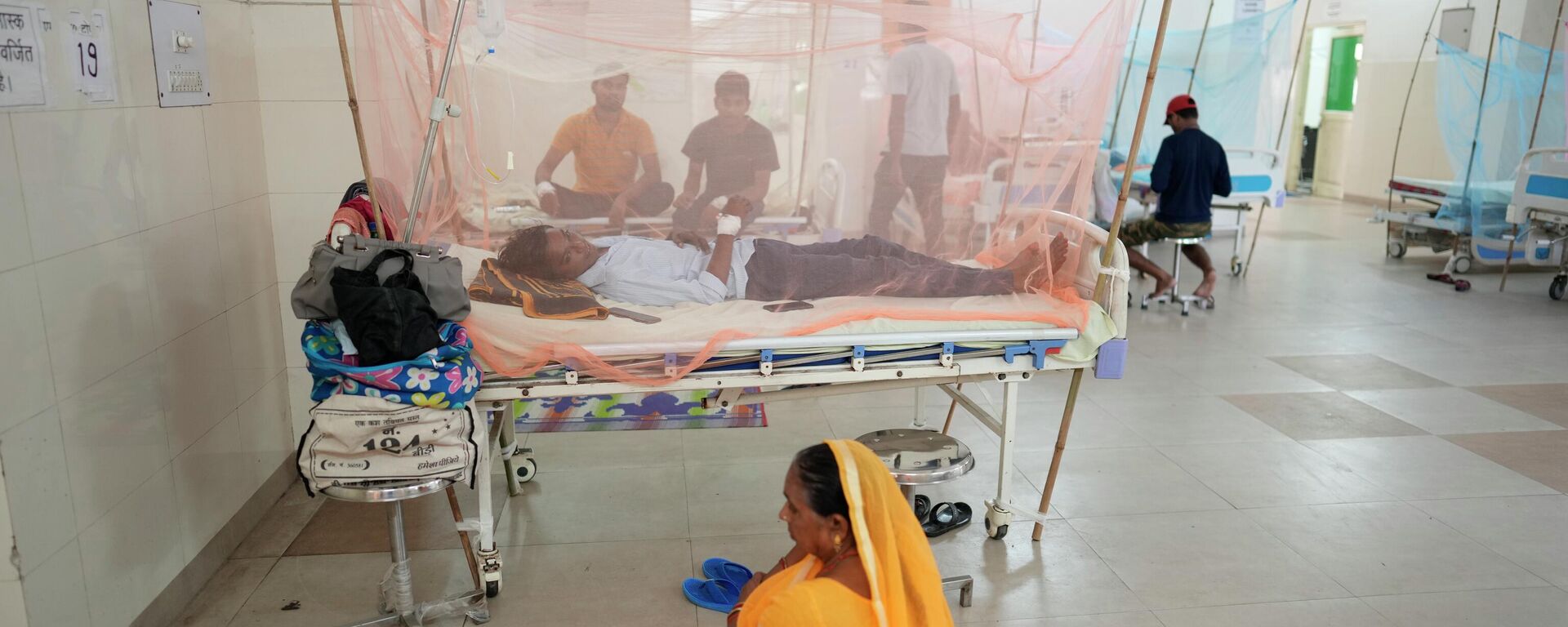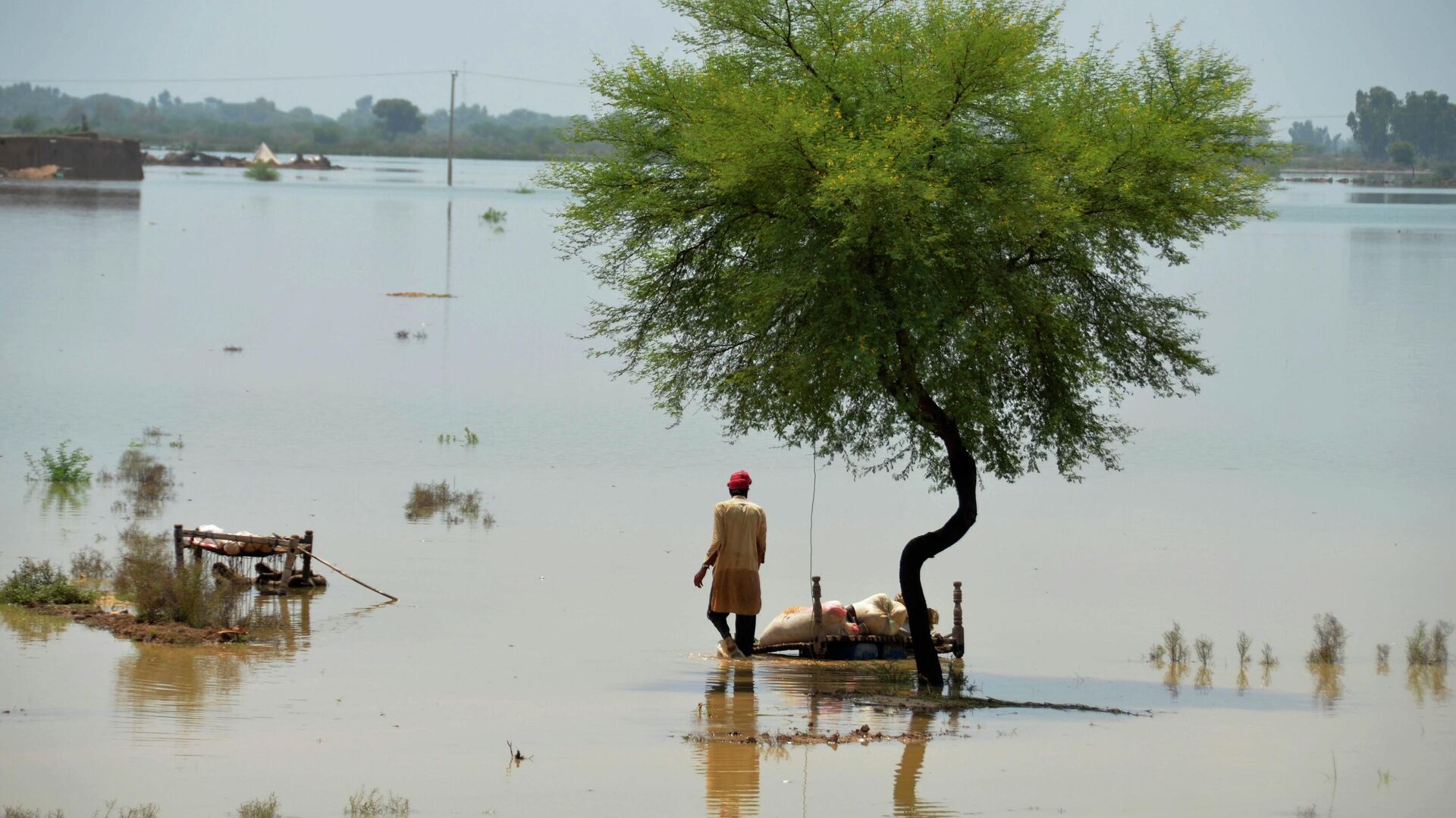https://sputnikglobe.com/20221115/massive-malaria--dengue-outbreaks-back-in-pakistan-following-devastating-floods-1104206229.html
Massive Malaria & Dengue Outbreaks Back in Pakistan Following Devastating Floods
Massive Malaria & Dengue Outbreaks Back in Pakistan Following Devastating Floods
Sputnik International
Pakistan was hit by severe flooding after torrential monsoon rains this summer, killing 1,500 people and displacing 33 million. Although water levels have... 15.11.2022, Sputnik International
2022-11-15T10:59+0000
2022-11-15T10:59+0000
2023-02-14T08:48+0000
world
health
malaria
dengue
centers for disease control and prevention (cdc)
pakistan
floods
https://cdn1.img.sputnikglobe.com/img/07e6/08/1e/1100176773_0:161:3071:1888_1920x0_80_0_0_5d888d6f3712f0db5c0fb98d52795af1.jpg
There are currently more than 3.4 million suspected cases of malaria in Pakistan, while 65,000 dengue fever cases have been reported since the beginning of the year, causing 147 deaths, according to the World Health Organization (WHO).Mumtaz was previously involved with top online pharmacy and health apps Sehat.com.pk and Ailaaj.The risk of these diseases is assessed as very high, taking into consideration the current flood crisis, which has caused the destruction of infrastructure, including hospitals and clinics, and insufficient relief effort to the national health system.The malaria outbreak has seen an exponential rise since last year. In 2021 there were 2.6 million reported cases within the country. This year's 3.4 million suspected cases have caused the WHO to call the situation endemic.So far, over 170, 000 cases of malaria have been laboratory confirmed, out of these, 77% were said to be caused by the bacterium 'Plasmodium vivax', and 23% by the 'Plasmodium falciparum', which is associated with the most severe and fatal cases.The initiatives included access to fumigation, bed nets, diagnosis equipment, special wards in the hospitals, and the availability of free anti-malarial medicines in both public and private hospitals and clinics across the country.Following the floods, however, a rapid rise in infections was seen in the provinces of Sindh and Balochistan, accounting for 78% of all the reported and confirmed cases in 2022.Life-Threatening InfectionsPeople get malaria after being bitten by an infective female Anopheles mosquito. It is not a contagious disease, so it is not spread from person to person like a cold or the flu. However, anyone can get malaria and develop serious or life-threatening complications.Mosquitoes carrying P. falciparum bacteria are the most dangerous, and if a person gets bitten by such a mosquito he/she needs to receive proper medical care as soon as possible.Those with little or no immunity to malaria, such as young children and pregnant women, can become very sick and die. Tourists and travelers coming from areas that have no malaria are also likely to become seriously ill after contracting it.Malaria is also life-threatening for poor people living in rural areas, who lack access to health care, timely treatment and suitable nutrition.Following the bite, the onset of symptoms can begin ten days to four weeks after infection, although there have been cases of a person falling ill as late as one year later.The symptoms include fever and flu-like feelings, including shaking, chills, headaches, muscle aches, and exhaustion. Furthermore, in some cases, nausea, vomiting, and diarrhea may also occur.If left untreated, malaria may cause anemia and jaundice (yellow coloring of the skin and eyes) because of the loss of red blood cells. That can lead to kidney failure, seizures, mental confusion, coma, and death.Another serious disease caused by a mosquito is dengue fever. It is a viral infection that is spread primarily by the Aedes aegypti mosquitoes. These types of mosquitoes are mostly found in Asian and Latin American countries.In Pakistan, dengue is wreaking havoc on the healthcare system because the virus-carrying mosquitoes have increased in numbers. Many infected patients requiring prompt medical care are unable to obtain such timely help due to the floods, especially in the rural areas of Sindh and Balochistan.Although dengue fever is not always dangerous, it can cause a very high fever 104 F (40C) in some cases. Other symptoms include headaches, muscle and joint pain, nausea, vomiting and swollen glands.In severe dengue or dengue shock syndrome, the symptoms can become life-threatening. This happens when blood vessels become damaged and leaky, causing the number of clot-forming cells (platelets) in the bloodstream to drop. This can lead to shock, internal bleeding, organ failure and even death. Warning signs of dengue shock syndrome include severe stomach pain, vomiting, difficulty breathing, blood in your nose, gums, vomit or stools.Prevention Methods & TreatmentIn the case of dengue fever, there is no specific treatment, as patients are asked to rest, stay hydrated and seek medical care if symptoms become severe. Some fever reducers and painkillers can be taken to help with fever and muscle aches.He further said that for those who are infected with dengue fever, it is vital to stay hydrated and consume foods rich in iron.In the case of malaria, a number of prescription drugs to kill the parasite are used. Chloroquine phosphate is the go-to treatment. However, in many parts of the world, malaria parasites have become resistant to chloroquine, and the drug is not always an effective treatment. In that case, Artemisinin-based combination therapies (ACTs) such as Coartem and Artesunate-mefloquine are used.In order to bring malaria and dengue under control, the government of Pakistan, with the support of the WHO, has been implementing some prevention methods.There has been mass distribution of mosquito nets in flood-hit areas, especially in Sindh and Balochistan, so that people can cover themselves while sleeping to minimize the risk of being bitten.The government has also introduced rapid diagnostic tests (RDTs) and antimalarial medicines in the provinces. Some 230,000 RDTs have been provided by the WHO for malaria and other diseases, including acute watery diarrhea, dengue, hepatitis A & E, and chikungunya.There has been the deployment of additional teams to support vector surveillance to identify high-risk areas or populations prone to infection and provide them with the necessary assistance.Overall, there is still an increased risk of serious health impacts from malaria and dengue in Pakistan. Considering the limited access to health facilities and insufficient healthcare workers and medical supplies, at this time efficient preventive measures are of vital importance.In order to reduce malaria transmission, governments and NGOs can focus more on creating public health messages to reduce the risk of malaria transmission, to create awareness of the risks and educate the masses on the importance of timely diagnosis and treatment options.
https://sputnikglobe.com/20220918/waves-of-death-who-warns-of-second-deadly-disaster-in-pakistan-after-floods--1100923408.html
https://sputnikglobe.com/20221102/scientists-find-terrifying-evidence-about-malaria-transmitting-mosquitoes-1102936948.html
https://sputnikglobe.com/20221005/asian-dengue-outbreak-no-panic-but-systematic-testing-needed-doctor-says-1101501390.html
https://sputnikglobe.com/20221021/dengue-patient-in-indias-up-dies-after-allegedly-receiving-juice-drip-instead-of-platelets-1102483003.html
pakistan
Sputnik International
feedback@sputniknews.com
+74956456601
MIA „Rosiya Segodnya“
2022
Aneela Rashid
https://cdn1.img.sputnikglobe.com/img/07e6/09/0e/1100768477_0:338:606:944_100x100_80_0_0_af078d1bbaf1e33c21f16169e9ed7a5f.jpg
Aneela Rashid
https://cdn1.img.sputnikglobe.com/img/07e6/09/0e/1100768477_0:338:606:944_100x100_80_0_0_af078d1bbaf1e33c21f16169e9ed7a5f.jpg
News
en_EN
Sputnik International
feedback@sputniknews.com
+74956456601
MIA „Rosiya Segodnya“
Sputnik International
feedback@sputniknews.com
+74956456601
MIA „Rosiya Segodnya“
Aneela Rashid
https://cdn1.img.sputnikglobe.com/img/07e6/09/0e/1100768477_0:338:606:944_100x100_80_0_0_af078d1bbaf1e33c21f16169e9ed7a5f.jpg
health, malaria, dengue, centers for disease control and prevention (cdc), pakistan, floods
health, malaria, dengue, centers for disease control and prevention (cdc), pakistan, floods
Massive Malaria & Dengue Outbreaks Back in Pakistan Following Devastating Floods
10:59 GMT 15.11.2022 (Updated: 08:48 GMT 14.02.2023) Pakistan was hit by severe flooding after torrential monsoon rains this summer, killing 1,500 people and displacing 33 million. Although water levels have since receded, there are still vast areas where large volumes of flood water remain stagnant. These have become a breeding ground for deadly mosquitoes.
There are currently more than 3.4 million suspected cases of malaria in Pakistan, while 65,000 dengue fever cases have been reported since the beginning of the year, causing 147 deaths, according to the World Health Organization (WHO).
"Dengue cases are on the rise but oftentimes this has been confused with Chikungunya, another mosquito-borne disease. These cases came about during the floods that affected various parts of Pakistan," health tech entrepreneur Bilal Mumtaz told Sputnik.
Mumtaz was previously involved with top online pharmacy and health apps Sehat.com.pk and Ailaaj.
The risk of these diseases is assessed as very high, taking into consideration the current flood crisis, which has caused the destruction of infrastructure, including hospitals and clinics, and insufficient relief effort to the national health system.
The malaria outbreak has seen an exponential rise since last year. In 2021 there were 2.6 million reported cases within the country. This year's 3.4 million suspected cases have caused the WHO to call the situation endemic.
So far, over 170, 000 cases of malaria have been laboratory confirmed, out of these, 77% were said to be caused by the bacterium 'Plasmodium vivax', and 23% by the 'Plasmodium falciparum', which is associated with the most severe and fatal cases.
"Pakistan had decreased malaria cases by 45% in the country from 2015 to 2020 through various healthcare initiatives, but that was before the devastating floods," Mumtaz said.
The initiatives included access to fumigation, bed nets, diagnosis equipment, special wards in the hospitals, and the availability of free anti-malarial medicines in both public and private hospitals and clinics across the country.

18 September 2022, 11:54 GMT
Following the floods, however, a rapid rise in infections was seen in the provinces of Sindh and Balochistan, accounting for 78% of all the reported and confirmed cases in 2022.
Life-Threatening Infections
People get malaria after being bitten by an infective female Anopheles mosquito. It is not a contagious disease, so it is not spread from person to person like a cold or the flu. However, anyone can get malaria and develop serious or life-threatening complications.
Mosquitoes carrying P. falciparum bacteria are the most dangerous, and if a person gets bitten by such a mosquito he/she needs to receive proper medical care as soon as possible.
Those with little or no immunity to malaria, such as young children and pregnant women, can become very sick and die. Tourists and travelers coming from areas that have no malaria are also likely to become seriously ill after contracting it.
Malaria is also life-threatening for poor people living in rural areas, who lack access to health care, timely treatment and suitable nutrition.

2 November 2022, 11:38 GMT
Following the bite, the onset of symptoms can begin ten days to four weeks after infection, although there have been cases of a person falling ill as late as one year later.
The symptoms include fever and flu-like feelings, including shaking, chills, headaches, muscle aches, and exhaustion. Furthermore, in some cases, nausea, vomiting, and diarrhea may also occur.
If left untreated, malaria may cause anemia and jaundice (yellow coloring of the skin and eyes) because of the loss of red blood cells. That can lead to kidney failure, seizures, mental confusion, coma, and death.
"Rapid Diagnostic tests for malaria and dengue are available at the pharmacies and online health apps," Mumtaz told Sputnik, with timely diagnosis being crucial in both cases.
Another serious disease caused by a mosquito is dengue fever. It is a viral infection that is spread primarily by the Aedes aegypti mosquitoes. These types of mosquitoes are mostly found in Asian and Latin American countries.
In Pakistan, dengue is wreaking havoc on the healthcare system because the virus-carrying mosquitoes have increased in numbers. Many infected patients requiring prompt medical care are unable to obtain such timely help due to the floods, especially in the rural areas of Sindh and Balochistan.
Although dengue fever is not always dangerous, it can cause a very high fever 104 F (40C) in some cases. Other symptoms include headaches, muscle and joint pain, nausea, vomiting and swollen glands.

5 October 2022, 08:07 GMT
"In Pakistan, amongst the locals, dengue is known as the 'break bone fever' as it is very painful," Mumtaz explained.
In severe dengue or dengue shock syndrome, the symptoms can become life-threatening. This happens when blood vessels become damaged and leaky, causing the number of clot-forming cells (platelets) in the bloodstream to drop. This can lead to shock, internal bleeding, organ failure and even death. Warning signs of dengue shock syndrome include severe stomach pain, vomiting, difficulty breathing, blood in your nose, gums, vomit or stools.
Prevention Methods & Treatment
In the case of dengue fever, there is no specific treatment, as patients are asked to rest, stay hydrated and seek medical care if symptoms become severe. Some fever reducers and painkillers can be taken to help with fever and muscle aches.
"High amounts of paracetamol are recommended alongside papaya leaf juice [which raises platelet levels], to be given to the patients. One pharmacy that has taken an initiative is Macter by releasing papaya syrup available at pharmacies," Mumtaz elaborated.
He further said that for those who are infected with dengue fever, it is vital to stay hydrated and consume foods rich in iron.

21 October 2022, 06:37 GMT
In the case of malaria, a number of prescription drugs to kill the parasite are used. Chloroquine phosphate is the go-to treatment. However, in many parts of the world, malaria parasites have become resistant to chloroquine, and the drug is not always an effective treatment. In that case, Artemisinin-based combination therapies (ACTs) such as Coartem and Artesunate-mefloquine are used.
In order to bring malaria and dengue under control, the government of Pakistan, with the support of the WHO, has been implementing some prevention methods.
There has been mass distribution of mosquito nets in flood-hit areas, especially in Sindh and Balochistan, so that people can cover themselves while sleeping to minimize the risk of being bitten.
The government has also introduced rapid diagnostic tests (RDTs) and antimalarial medicines in the provinces. Some 230,000 RDTs have been provided by the WHO for malaria and other diseases, including acute watery diarrhea, dengue, hepatitis A & E, and chikungunya.
There has been the deployment of additional teams to support vector surveillance to identify high-risk areas or populations prone to infection and provide them with the necessary assistance.
Talking about precautions that people in the cities can take, Mumtaz recommended, "Wearing long-sleeved clothing that isn’t too bright in color and using mosquito repellents. There are many repellents available in the market that are chemical (Deet) free and some that even use natural ingredients like Aura's Repello which has Citronella plant extract. Growing Citronella or even Basil plants at home as a precautionary method can repel these mosquitoes."
Overall, there is still an increased risk of serious health impacts from malaria and dengue in Pakistan. Considering the limited access to health facilities and insufficient healthcare workers and medical supplies, at this time efficient preventive measures are of vital importance.
In order to reduce malaria transmission, governments and NGOs can focus more on creating public health messages to reduce the risk of malaria transmission, to create awareness of the risks and educate the masses on the importance of timely diagnosis and treatment options.









